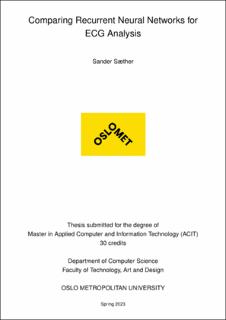| dc.description.abstract | In this thesis, the effectiveness of three types of Recurrent Neural Networks (RNNs) - Basic RNN, Long Short-Term Memory (LSTM), and Gated Recurrent Unit (GRU) - are examined for Electrocardiogram (ECG) signal classification. We categorize ECG signals into five classes: normal, myocardial infarction, ST elevation, conduction disorder, and hypertrophy, with a thorough process of data preparation ensuring optimal conditions for model training and evaluation. This study aimed to compare the performance of three types of recurrent neural networks (RNNs) - basic RNN, Long Short-Term Memory (LSTM), and Gated Recurrent Unit (GRU) - in classifying electrocardiogram (ECG) signals into five categories: normal (NORM), myocardial infarction (MI), ST elevation (STTC), conduction disorder (CD), and hypertrophy (HYP). The research was confined to the analysis of the PTB-XL dataset, a large publicly available ECG dataset. The performance of each model is evaluated based on several metrics such as accuracy, precision, recall, and F1 score, with a separate dataset used to assess their ability to generalize. The LSTM model emerges as the most effective, demonstrating the highest accuracy (87.89\%), precision, recall, and F1 score. The methodology involved preprocessing and preparation of the PTB-XL dataset, designing and implementing the RNN, LSTM, and GRU model architectures, and training, validating, and testing these models. The performance of the models was evaluated using a separate validation dataset after each training epoch and tested on a separate test dataset. Further insights are obtained from an analysis of confusion matrices. The basic RNN model, though proficient in classifying normal ECG patterns, struggled with the classification of abnormal classes, representing a significant limitation in a clinical context. Both the LSTM and GRU models, on the other hand, were more capable in identifying abnormal cases and differentiating between classes, with the LSTM model demonstrating a more balanced performance. In conclusion, LSTM models proved to be the most effective for ECG signal classification among the three types of RNNs evaluated. However, there is potential for further improvement and optimization, including hyperparameter tuning, ensemble methods, and the integration of other types of neural networks like Convolutional Neural Networks (CNNs). Future work could also investigate cost-sensitive learning or other methods to minimize misclassification.Overall, the adoption of advanced machine learning models, particularly LSTM, could significantly improve the speed and accuracy of cardiac disorder diagnosis, ultimately leading to better patient outcomes. Despite LSTM's superior performance, the potential for future research to explore model optimizations and integrations with other neural network types, such as Convolutional Neural Networks (CNNs), is recognized. The study concludes by highlighting the importance of considering the high cost of misclassification in clinical settings, suggesting that future work should focus on cost-sensitive learning. | en_US |
